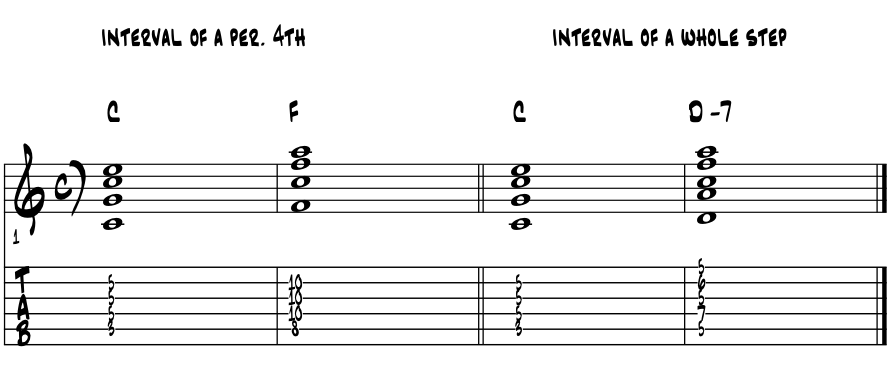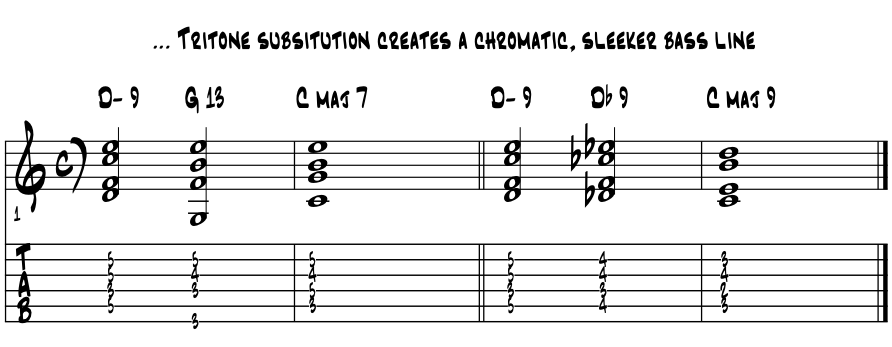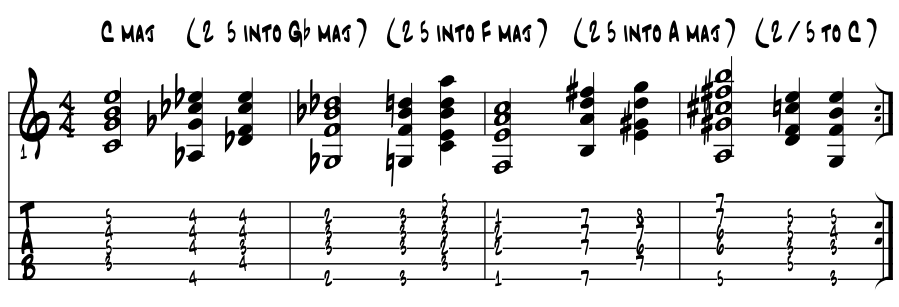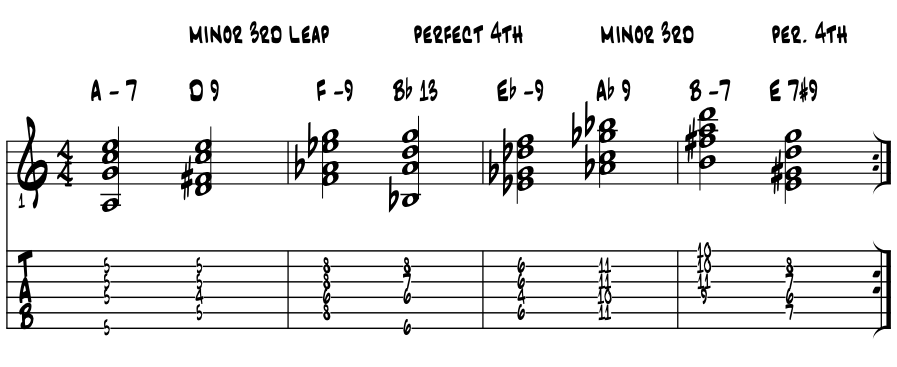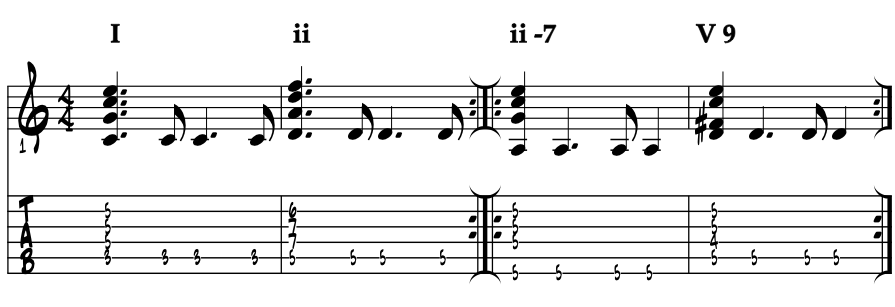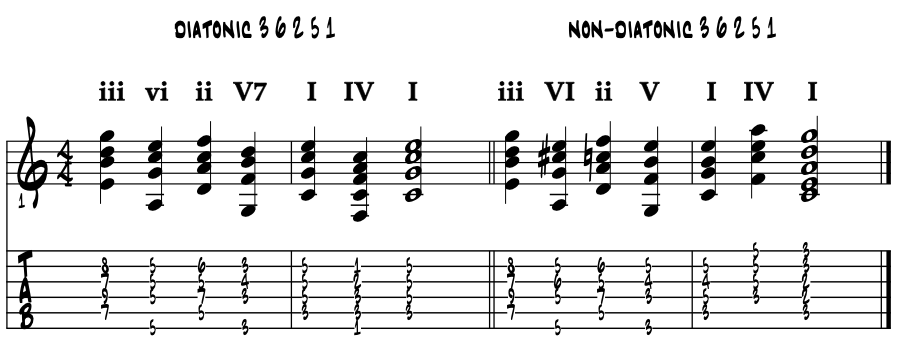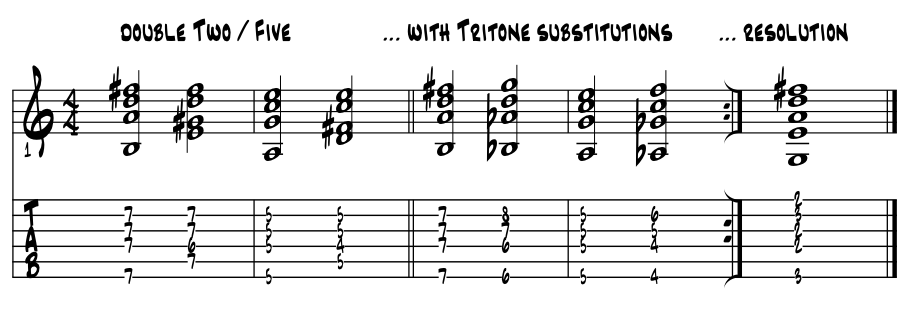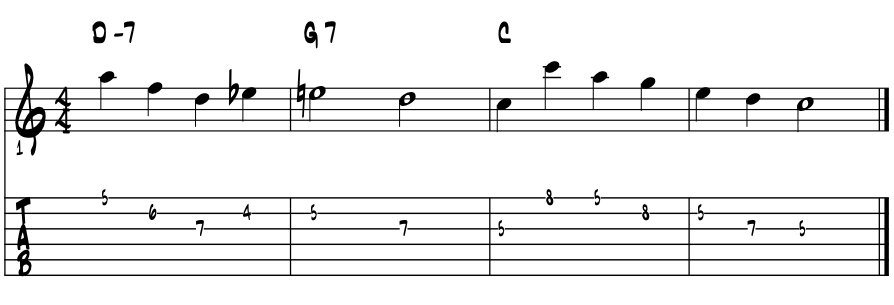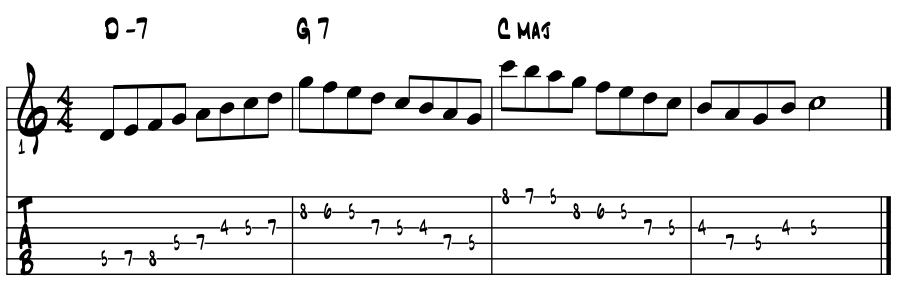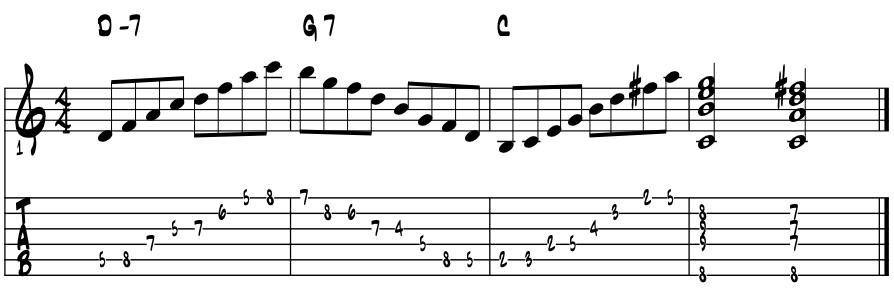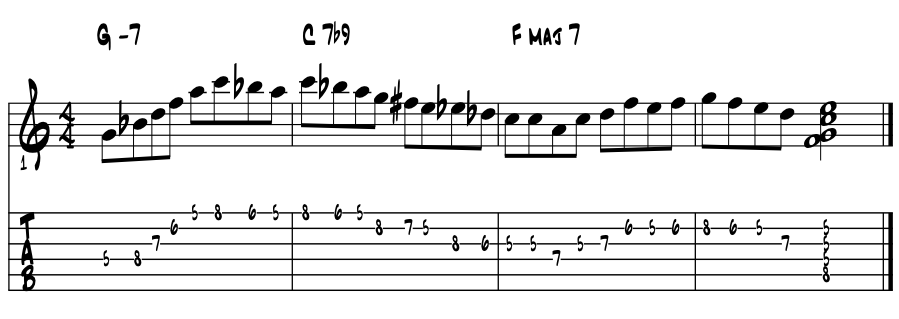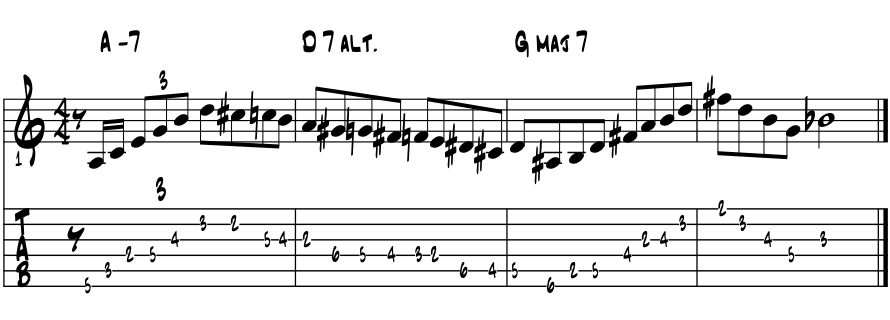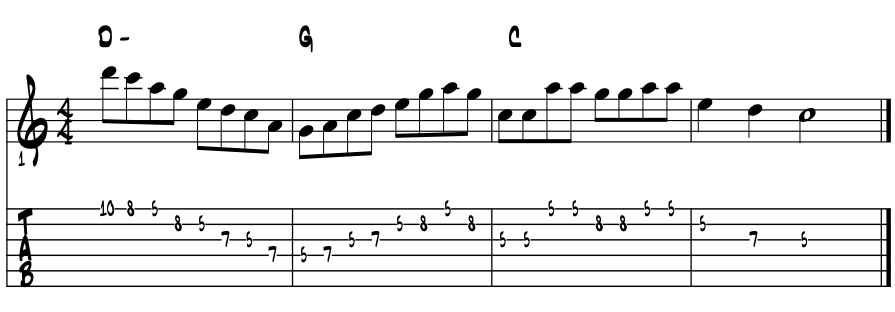~ Two / Five / One ~
|
In a nutshell. The 'Two / Five / One' cadential motion is a kind of pivot point in the evolutions of ways to jazz up the many common chord progressions that foundation the Americana songbook. In the jazz leaning style leaning towards brighter (faster) exciting dance tempos, especially during the swing to bop eras, so 1930's till 1950 or so, in song after song, this '2 5 1' bass / chord motion is the cadential motion used to harmonically take us anywhere and everywhere a song might want to go. Thinking major key and adding a 7th to each triad, its three unique chord types (251) create a sort of tension / resolution template for the arpeggios, which can bring forth our emotional energies in tempo ranges from a 'slow as molasses' grind to the 'fast in the blink of eye.' |
In minor, '2 5 1' brings a deeper hue potential into the minor tonal colors with nine possible diatonic pitches, and the arpeggios and chords they diatonically generate. With the Two / 'ii -7b5 / half diminished, the Five / V7 capable of either major or minor triad and augmented and diminished color tone shadings, One / i -7 / the min / maj 7 ~ triad colortone pairing, i -9, sus 11, 13, and four minor diatonic modes created from a seven pitch core. Minor key and its '2 5 1' love to borrow pitches ! And there's no reason why these 'minor tensions' and resolves can't disguise resolutions towards major key centers. |
Just the tension. So there's all of the above colors for creating resolving cadential motions ( tension / release ) and by leaving off the tonic / One chord, we still retain the interval dissonant energy of the Two / Five cell. For many jazzers since the 30's, the '2/5' cell is a 'shortcut' to 'correctly', meaning in theory, take the music to any one of the 12 points within chromatic realm. Implied towards or actually resolved to a key center, the Two / Five cell wins the day for the jazz leaning, soloing through the changes empowered artists. |
In the blues. In basic 12 bar blues, when the turnaround from the 9th bar evolves from '5 4 1' into '2 5 1' for the last four bars of the form, the 'sleeker' nature of the '251' cell helps the music go faster, and faster and even faster. And the literature through the decades tells us just how true this is; of the 12 bar blues roots continuing to evolving the jazz language. |
Walk on up walk on down. Building on aural 'blues predictability', as we advance our number of pitches from the pentatonic five to diatonic seven and further to the chromatic 12 pitches, each new added pitch along the way can add a greater sense of confidence and clarity to our motion towards a tonal destination. For just like the pure Americana 'Muddy walk-up / walk-down' turnaround, walking up from Two into Five leaves no doubt to aural direction, that brooks no fooling around to where the music is going, regardless of whether it resolves to a tonic or not, thus creating the ever essential 'Two / Five' vamp, that'll have been and will be filling dance floors this Saturday night, so come on out. |
Two / Five evolves. The two added pitches to the core 'pentatonic 5'; the '4th and 7th' scale degrees combine to make a 7 pitch group, the '4 and 7' notes also creates the tritone interval within the group's Five 7 chord. We also add a 7th to One and now have a minor 3rd for the Two chord as well ... kaboom :) (5) C D E G A ~ becomes ~ (7) C D E F G A B C And by evolving our progression from Four / Five / One to Two / Five / One, our theory advances dramatically as now each of these three chords of '2 5 1' are their own 'chord type' of 7th chord, each bringing its own new dimension of tonal gravity function within a key center. So in a sense we're just swapping Two for Four, by slipping a new bass note underneath the triad built on Four to create Two / ii -7. Thinking in 'C' major. F A C becomes D F A C Nothing could be simpler really, yet thanks to the combined creative of the Legends of Americana Music, have such a colossal effect on modernizing chord progressions; all manifested by what's organically built into our theory systems and simple root note proximity, '2 5 1' cadential motions bops right on through all of our Americana styles and genres of today (in ballads too :) |
S T G C. As crazy as it sounds, for some folksy, bluesy to rockers, bluegrass country artists looking to jazz up their scene, understanding how the Two / Five motion energizes a gravity towards One can be a game changer, exploding our palettes to all points of the harmonic, thus melodic, compass. Coupled with an understanding of creating 1/8 note styled single line melodies to run over these changes, we kaboom to a lifelong journey of the magics of '2 5 1' musical evolutionary discovery and coolness. How ? Why ? Well, read on :) |
"Muddy" from the 2, 5 and 1. All through our Americana musics, the predictability and energy of the 'muddy' lick sets in motion a super clear cadential direction to a future point of resolution in time. When when we combine this magic up with the '2 5 1' cadential motion powers, and its cycle of 5th's predictability of its bass line and harmonized with our three chord types, we kaboom and get a wide variety of cadential potentials that can range all through and find their places through all the styles. While mostly leaning blues and jazz in style, once the basics of these pitches and motion are under our fingers, new licks generate almost of their own accord. Here's a few fairly common 'muddy' riffs combined with the energy of the '2 5 1' cadential motion. So just some start points creating a basis to explore from. Example 1z. |
going up ... in 'G' |
flip it over |
now up ... then down |
bring in 6 :) |
jazz it up with chords |
|||||
Jazz it up 'nut' with chords. Of our most common harmonic motions, created by mixing up the diatonic major and minor triads, the One / Four and Five triads as found within the a key center, as we find ways to add in more of the Two chord into our progressions, new opportunities manifest. These can be in melodies, bass lines, chord substitutions. Which in themselves create new melody possibilities and bass line stories. For example, please examine this motion between One and Four. Thinking 'C' major. Example 1. |
Sense the greater energy to get to Four via Two / Five? Click it again. Catch the 'Bb' note in the Two and Five chords? This one pitch changes helps to energize a 'fuller' motion to 'F.' As the note 'Bb', is diatonic to 'F' major. And of course, we've added a 7th to the Two and Five chords, juicing them up a bit more. |
Essence of a turnaround. In our musics, in all styles really, there's this thing called the turnaround in a song. And as its name implies, it 'turns us around' to begin the cycle of the song and its form. While most any chord or phrase can be a turnaround, our Americana musics have turnarounds that have historically defined musical style over the last 100 years or so. Five to One is the most common turnaround. Often proceeded by the Four chord, we evolve our a bit by swapping Two for Four. |
Change the groove in the turnaround. In our musical beginnings, the New Orleans tradition of performing for the memorial service of loved ones departed, we find a way pure Americana way to 'jazz up' our arrangements of today. That when the procession was heading to the interment grounds, the music of the walk was slow and somber, befitting the gravity of the occasion. Upon completion of the service, the 'march' back to home, while dignified and graceful, had some swing in the step, so more probably upbeats and a brighter tempo. In our studies here, we just want to recognize that the turnaround point, in the form of the song we're playing, is an pure and cool 'access' point to slip in 'mood shifts' of tempo, bring the swing as the saying goe'd. |
|
Especially in the blues ? Yep. The 'muddy' walkdown pitches create a big window to shift the tempo gears. Critics might call this cliche, as Hollywood embraced this memorial service drama and then immortalized the scene in movies. But it works like a charm for having fun with music, giving everyone a way into this high steppin', combined change of heart and spirit moment when making music, wherever we may be. |
|
Two / Five / One ~ evolving Four into Two. Using our chord spelling chart, please examine how easily Four evolves into Two. This theory of 'one click back' in the arpeggio makes all the difference. Example 2. |
diatonic chords |
I |
ii |
iii |
IV |
V |
vi |
vii |
VIII |
scale degrees |
1 |
2 |
3 |
4 |
5 |
6 |
7 |
8 |
scale pitches |
C |
D |
E |
F |
G |
A |
B |
C |
arpeggio degrees |
. |
. |
. |
. |
. |
1 |
3 |
5 |
arpeggio pitches |
. |
. |
. |
. |
. |
F |
A |
C |
arpeggio degrees |
. |
. |
. |
. |
1 |
3 |
5 |
7 |
arpeggio pitches |
. |
. |
. |
. |
D |
F |
A |
C |
That's it. F A C becomes D F A C. |
2 / 5 / 1 ~ Built for greater speeds simply by proximity of our root note pitches. Things built for speed tend to be sleeker in shape and form. In our music theory case here, this is reflected in the bass line story and its motions. First off, Four is intervalically located a perfect 4th interval from One, so two and a half steps or five frets. While the Two chord is separated by a just one whole step, or two frets, from One. Surely this closer proximity creates a sleeker motion. Compare these intervals moving from One. Example 3. |
Cool huh? Yea, sleeker means quicker so generally moving in a jazz style direction. We've a further interval reduction / proximity with Two / Five. Hip to the V7 'tritone sub' yet? Still thinking in 'C' major, now with some jazz chord colors. Example 3a |
Seen this before? No? Another first? Right on ! The tritone sub is a game changer no doubt, and usually too easy to sound out, not to know about :) Learning of it here just might be = price of admission for U Y M. |
2 5 1 in modulations. Using the Two / Five / One motion makes changing from one key center to another a snap. Move to any key, major or minor, via 2 5 1. Boom boom boom ... and then 'legally' in a new key. And while in pure theory we really don't need the Two chord, including it just sweetens the deal. Starting in 'C' major. Example 4. |
Four different keys in four bars ! That's gotta be a record of sorts :) Sense how Two / Five leans towards each new key center ? Cool. The Five chord is the traffic cop directing all these modulations of course, the Two chord creating the launch pad for the lines. |
Point to ... but don't have go to. A second idea, in regards to modulations and key centers, is how we can employ the Two / Five as a self standing 'cell.' Strong enough on its own that there's no need to resolve to One. These non-resolving Two / Five motions generate nice energies in all our styles. In this next idea, we cycle through various Two / Five pairings. Example 5. |
A minor 3rd / perfect fourth cycle ? We've seen this before yes ? Some may have, if not explore it here :) Regardless, the Two / Five cell is one boppin' around cat that rolls to where the music needs to go, 24/7. |
Two tunes. Two amazing songs from wayback, that feature elements of this Two / Five / One cycle, both will still fill the dancefloor and gets listeners jamming along with their own reminisces. The first, with the One and two chords, went to # 1 of the top 10 back in the 60's And the second? The Two and Five chords only, and chances are it'll be filling the dance floor somewhere this coming Saturday night. Both are 'two chords' and the truth. Lifting the keys from the recordings, marvel at the simplicity. Example 6. |
Simplicity in composing sometimes IS the magic eh ? And that both of these motions make solid vamps sort of seals the deal. pro leaning ? Learn this two songs in a couple of keys, words too. |
The diatonic 'double - up.' Just turns out that in our diatonic realm of tonal organization, we can easily create two varieties of a 'double Two / Five' cadential motion. The first is pure diatonic, no altered pitches. The second, we alter or borrow one note to firm up our chord type, into a pure Two / Five' cell, as discussed just above. Thinking in 'G' major, please examine these resolving motions. Example 7. |
So we borrowed the 'C#' ... ? A sharp One? Yep, a '#1' note, in relation to our tonic One, a 'C' note :) All hidden in the third measure. This way our Six chord becomes a V7 chord type. Thus creating a Two / Five cell. Where common? In jazz musics of course :) And for some adventurous blues too ! Important? Yep, # One opens into the theory of chord substitution, thus Coltrane and forward. But dig this next idea of fast moving Two / Five cells featuring the 'tritone substitution' for the second go around. Thinking in 'C', cycling a '3 6 2 5' to make a vamp or interlude, an intro, outro etc. Example 7a. |
Dig this next idea of fast moving Two / Five cells featuring the 'tritone substitution' for the second go around. Thinking in 'C', cycling a '3 6 2 5' to make a vamp or interlude, an intro, outro etc. Example 7a. |
Cool ? Yea we're jazzing it on up :) Sounds very cycle of fourths n'est-ce pas? Surely it is Amigos, surely it is. Ya hip to this organizational magic of all our combined AmerAfroEuroLatin musical art ? And shouldn't 3 6 2 5 have its own discussion ? Yep, prolly should. So ... explore some more and write your own eh ? |
Author's muse ... Two / Five evolution ? In the bebop style jazz music created on through the 1940's, composer Charlie Parker wrote well in excess of 50 compositions. If we could somehow sift all this music down and place it on some sort of chromatic theory graph of pitches and chords, I'd bet there would be zero spots left uncovered. That every nook and cranny of what could musically occur did occur. Mr. Parker covered it all and often in very bright tempos and chances are good that Parker used a Two / Five motion to get there ... :) |
In single line melodies. In creating single note lines, Two / Five is an ultimate ride. Super sleek, super fast or slow it all on down and groove to Four, there's a lot of room for the creative. Thinking in the 'relative' keys of 'C' major / 'A' minor, this first 2 5 1 idea adds in one non-diatonic pitch and closes with the pentatonic color on the tonic chord. Example 8. |
Sounds like a line for "Satin Doll?" Sure why not, as there is five or six of these Two / Five cadential motions in this classic song. In this next idea we're moving stepwise, root to root, connecting up our three chords with diatonic pitches. Thinking in 'C' major. Example 8a. |
|
A lot of black dots yikes ! From this scale basis we now evolve the arpeggios for each of the chords. Example 8b. |
Hear the chords nice and clear in the single note melody line? Click it again if needed. Hearing the changes in the line is the old fashioned way, probably cause it just makes sense :) There's that built in forward motion of the phrase that hints as to where this melody is going to go. While mostly diatonic, the One chord 'C' gets a nudge off by starting on the 7th degree, the leading tone. Extended to a full 13th before settling in on Five, the F# is the '#11', a colortone of polytonal proportions. In this next idea we arpeggiate then stepwise in the key of 'F' major. Example 8d. |
' ... There must have been some magic ... :) Nice Two chord arpeggio shape yes? From the 'butter' shape of the core shapes of modern guitar. Movable? Totally. And some diminished color in the middle? Yep. Pure diminished scale actually, thinking of the Five chord as a 'C7b9.' And that opens some possibilities ! Jazzing up the last idea a bit further with some chromatics and blues with a nod to Mr. Parker. Example 8e. |
Off beat straight up arpeggio launches the line on Two which sets up a chromatic descent on Five towards One, which is a reverse arpeggio followed by a hint of the blues upon resolution. In this next idea we sub some major pentatonic colors to find our way through Two, into Five and resolving to One. Example 8f. |
Sound easy and carefree? Catch the riff of another song at the end? Cool. Using the five note pentatonic colors for creating Two / Five / One lines has various ways to shape the music. Pioneered in jazz in the early 60's, there's a whole school of thought as how the colors can shape the wide palette of colors for the modern artist. |
Coltrane pioneers the next new. Through a decade or o of hard work, Coltrane finds a new pathway and shares it with us all in the writing of his compositions. To good to be true really, for the theory is quite manageable once the basics are in place. Coltrane simply uses the diminished 7th chord in V7b9 to create a '3 6 2 5' motion that swaps cycle of 4th bass / root motion for some chromaticism. Thinking in 'Eb' ... 'G / C / F / Bb to Eb' becomes 'E / A / F / Bb / to E' |
A bit further along, Coltrane evolves the diminished symmetry of the minor 3rd interval in chord progressions mixed with the more traditional 4th's. This motion is written into the song "Lazy Bird." Within a year or so, Coltrane presents his ballad "Naima" and "Giant Steps", both of which distill these motions of the minor 3rd / perfect 4th, with "Naima" including chromatic motion also. "Giant Steps", as the title implies becomes the global gamechanger for the studious cats then and now. |
|



